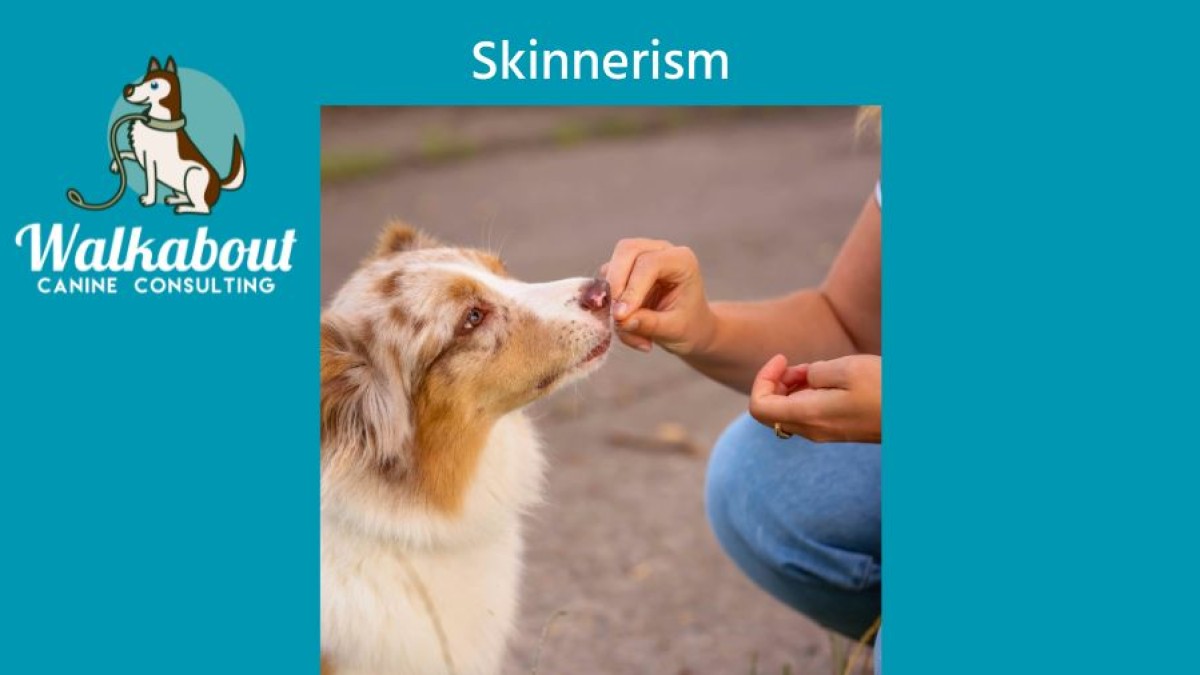Positive Dog Training & Behaviour Blog | Walkabout Canine Consulting
Unleashing your dogs potential, one concept at a time
Do you want to know more about Skinnerism?

He believed behaviour is a function of its environment, not of hidden thoughts or emotions. “What we do is shaped and maintained by what happens after
I wanted you to have this learning so I asked Chat GPT to write up a concept that can be helpful when teaching our dogs.
It might be to much science or maybe not, you can let me know what you think about it.
Sylvia great question. I dug into Skinner’s writings and the behavioural-science literature. The short answer: your “DISC” (Deprivation, Immediacy, Size, Criteria) captures important factors in reinforcement effectiveness, though Skinner himself didn’t always package them under that acronym. But modern behaviour analysts often use very similar dimensions (sometimes called “dimensions of reinforcement” or “parameters of effective reinforcement”). Below is what I found, plus how each of your four factors affects learning (and some nuances to watch out for).
What Skinner / Behavior Analysts Say About These Factors
Skinner’s original writing (e.g. Science and Human Behavior) and later behavior-analytic work don’t explicitly label “DISC” as a package. But the elements you list correspond to well-established principles. For instance:
-
Deprivation / motivating operations / establishing operations
Skinner used the idea of deprivation (or satiation) in discussing primary reinforcers (e.g. food). The more deprived an animal, the more effective the reinforcer tends to be (within limits). Appalachian State University+2bfskinner.org+2
In more modern behaviour analysis, the term “motivating operations” (or “establishing operations”) is used to describe how deprivation or aversive states change the value of a reinforcer.
Also, for Skinner’s mand (verbal requesting) analysis, he stipulated that a mand is under control of deprivation or aversive stimulation. Wikipedia -
Immediacy
Skinner emphasized that reinforcement must follow the behaviour promptly to effectively strengthen it. Delayed reinforcement reduces efficacy and can fail to establish a clear contingency. That is a central point in operant conditioning. bfskinner.org+2Open Text WSU+2
Empirical research supports this too: delayed reinforcement is less effective and hinders extinction (i.e. makes the behaviour less robust) compared to immediate reinforcement. ScienceDirect -
Size (or magnitude / strength)
The magnitude (or amount/intensity) of the reinforcer matters. If the reinforcer is too small, the behaviour may not increase. If large enough, it can produce faster learning or stronger maintenance. Skinner and his contemporaries talk of “amounts of reinforcement,” “magnitude,” or “strength” of reinforcers. bfskinner.org+1
However, more isn’t always better—there are diminishing returns, satiation, or competing reinforcers to consider. -
Criteria (i.e. the “contingency” or how strictly you define the behaviour that earns reinforcement)
Here, you’re referring to what exact response (or variation) will be reinforced. This aligns with Skinner’s notion of operant classes, contingencies, and selection by consequences. The “criterion” determines whether a given response qualifies for reinforcement. Skinner carefully discusses how the operant is defined by the property on which reinforcement is contingent (e.g. “the height to which the head must be raised” in his experiments) Appalachian State University+1
Also, more recent work frames this as contingency / discriminative stimulus control / response class definitions. bfskinner.org+1
So your four factors map quite well to key, empirically supported parameters of reinforcement. Behavior analysts sometimes expand the list (e.g. adding contingency, quality, effort, satiation, duration), but your four are solid core ones.
How Each Factor Affects Learning — With Examples & Trade-offs
Let’s look at each “DISC” factor in training contexts (e.g. dog training) and the trade-offs or caveats you’ll want to keep in mind.
| Factor | Effect on Learning | Example / Dog Training | Pitfalls & Caveats |
|---|---|---|---|
| Deprivation | Increases the value of the reinforcer, making the learner more responsive | If a dog hasn’t had food for a bit (within safe limits), food treats are more motivating. | Too much deprivation creates stress, reduces welfare, or causes other undesirable behaviour (e.g. frustration). Also, for social or toy reinforcers, deprivation might work differently. |
| Immediacy | The more immediate the reinforcement, the clearer the link between behaviour and consequence; better learning and discrimination | Mark a behaviour (e.g. with a clicker or marker word) immediately, then deliver the treat (within fractions of a second) | Delays introduce ambiguity—other behaviours may “steal” the reinforcement. If you can’t deliver immediately, you risk reinforcing something unintended. |
| Size / Magnitude | Larger or more preferred reinforcers can produce faster and stronger learning | Using a very tasty “jackpot” treat for a big win; reserving high-value treats for hard criteria | Overuse of big reinforcers can lead to satiation (the dog becomes less interested). Also, too large may overshadow shaping of subtler behaviours. |
| Criteria / Contingency | The more precise and appropriately incremented the criteria, the better you can shape behaviour; stricter criteria (when used carefully) push the learner to higher performance | If you want a dog to “look at your hand,” you might start by reinforcing any head turn, then gradually raise the criterion to direct eye contact. | If criteria are too strict too soon, the learner may never catch those behaviours (frustration). If criteria shift too fast, you lose performance. Also, responses just below criterion don’t get reinforced, which may cause extinction bursts or variability. |
Interactions & relative weighting
These factors don’t act independently. For example, a slightly delayed reinforcer may still work well if the reinforcer is extremely potent and the learner is highly deprived. Conversely, an immediate but weak reinforcer may not do the job. The balance among them matters.
Summary & Recommendation
-
Your “DISC” framework captures core, evidence-based parameters of effective reinforcement (deprivation, immediacy, size, and criteria).
-
Skinner himself didn’t use the acronym “DISC,” but his writings (and later behavior analytic literature) clearly presuppose those dimensions.
-
In practice, when planning a behaviour-shaping or training protocol, always evaluate:
-
Has the learner been deprived enough (but not too much)?
-
Can you deliver the reinforcer immediately (or have a way to “bridge” delay)?
-
How big or attractive is the reinforcer?
-
Is your response definition/criteria set properly and shifting at a pace the learner can follow?
-
Categories: : dog behavior, dog behaviour, dog training, dogtrainingtip
 Sylvia Koczerzuk Koczerzuk
Sylvia Koczerzuk Koczerzuk 
